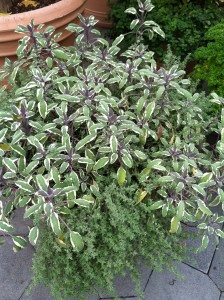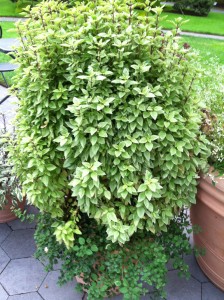Giving Herbs the Space to Succeed
Posted in Horticulture on November 18 2014, by Sonia Uyterhoeven
Sonia Uyterhoeven is NYBG‘s Gardener for Public Education.

I was watering containers around the Café one weekend in September when a woman stopped me to ask some questions about herbs. She had seen the large containers of parsley on display and was wondering what we did to keep the plant so healthy.
She explained that she had purchased parsley this summer and had placed it on her windowsill in her kitchen. It was not as verdant and vibrant as ours, and she was wondering what she had done wrong. I explained that our container displays comprised several plants to create a lavish appearance, but it was not simply quantity but also the size of the container that produced the bountiful display.
For your herbs to thrive, they need ample space to grow. Herbs are generally sold in spring in small, three- to four-inch pots. The small sizes of the pots are convenient for growers and it keeps the price down. Once you bring it home, the herb will need a bigger home so the root system can expand to support the plant.
If the herb is to be placed on your windowsill within arm’s reach of your cutting board, you probably won’t be able to repot it in a larger container, but even bumping it up to a six-inch pot will make a world of difference.
Most of the herbs you grow on your sill will thrive in full sun. If you only have partial light, then growing parsley, chives, and mint are probably your best options. Herbs are light feeders and do not need to be fertilized on a regular basis. Adding a small dose of organic fertilizer once a month should be adequate. Alternatively, a handful of compost added to your potting soil will keep most herbs satisfied.

If you have space for larger outdoor containers, there are many culinary and ornamental herbs that will thrive while adorning your patio.
This year we combined tricolor sage (Salvia officinalis ‘Tricolor’) and silver thyme (Thymus vulgaris ‘Argenteus’) to create a pleasing infusion of purple, green, and white. The similar shape of the leaves of the two herbs—in dramatically different sizes—created a textured display, and the under-planting of the variegated thyme enhanced the variegation of the sage and brought out the intensity of its purple stems.
The thyme and sage were complemented by another container which paired variegated lemon-scented basil (Ocimum × citriodorum ‘Pesto Perpetuo’) with oregano (Origanum vulgare ssp. hirtum). The variegated basil, with its tall columnar shape and purple flowers, blended beautifully with the adjacent containers.
As for the parsley, a blast of color was added to the container of curly parsley (Petroselinum crispum) with the inclusion of golden oregano (Origanum vulgare ‘Aureum’). These low-maintenance herbal containers added an attractive edible element to our café container display this year.


I like the idea of planting herbs in a container. I have a little jar in which I planted parsley but nothing happened. I think that my jar was too small for such a herb. Regards!